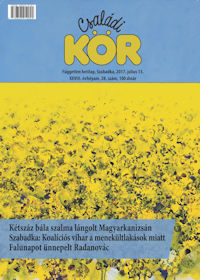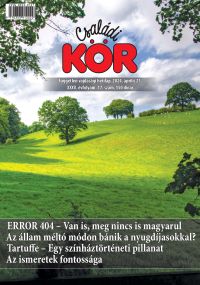
Our magazine’s covers promote artists from our own environment. Here, a typical Vojvodina/Vajdaság landscape by Endre Penovác: Rapefield
Our Family Circle (Családi Kör) weekly magazine offers almost everything that interests the various members of any family’s circles. It figuratively knocks on the door of subscribers and awaits thousands of loyal readers every Thursday on the neighborhood news stand with 68 pages full of intriguing content.
Fathers and men in general are, of course, interested in politics: in what happens around their neighborhood, city, province, country, and the world. So, about one quarter of the weekly opens with the most interesting events of the week, emphasizing at least one most important topic in Vojvodina/Vajdaság, Serbia, Hungary, and the Global Village. Courageous, outspoken commentary and opinion pieces are also order of the week.
Mothers and women are generally also interested in what is happening in their world, so the above contents vie for their attention as well. But their interests may be much wider and richer as they usually spend a lot of time caring about the health of their family members, about what makes it to the dining table of the home, and about those in the family who need the most attention, the weak and the sick. The beauty of each home frequently springs from underneath female hands, be it in the house or in the garden. Family Circle has a section for each of those interests.
Admittedly, this may sound like an old-fashioned division of household and public chores, but we do care about the lifestyle of the majority of our readers.
Even children have their own section where they find quality readings, logic puzzles, and poems. Our literary editor pays special attention to the selections for our youngest readers. Grandparents may be interested in the news and tips of the retiree section called Rocking Chair.
But the magazine naturally offers sections and content that cuts across the age and gender divides of categories of readers. We have a uniquely fascinating Sports section, a free-rolling Automotive section, a legendary Anglers section, crossword puzzles, humor, and we are preparing the best TV program in the Hungarian media space.
When Family Circle first appeared on newsstands and living room tables of Hungarian families in Vojvodina at Christmas time, 1990, its founders chose for its title a well-known image from one of the favorite family-life-celebrating poems of all time, from János Arany’s „Családi kör” („Family Circle”). The first few lines of this legendary poem will sound familiar to everybody around the world who has ever attended a Hungarian grammar school (translation by Neville Masterman):
The evening comes and everything is hushed,
while darkly nods the leafy mulberry tree;
And sure enough, the first logotype of the magazine included a silhouette of the mulberry tree so familiar to inhabitants and visitors of Vojvodina. But referring to the rural, pastoral idyll painted in that 1851 poem suggested something else: The founders of the magazine had expected that their public would be tired of the political bickering and sharp divisions of former Yugoslavia of the 1980s, and that they would turn their attention, time, and energy, to the quality of life.
History however, as we painfully learned, took a very different turn, and the political conflicts of the day soon turned into bloody wars, five, to be exact, and the only post-Yugoslav state that was involved in all of them was Serbia where Family Circle had originated and survived for over 27 years. Its original concept also survives to this very day as its new editors also profess that the magazine is about and for its readers, not politics and politicians. That everyday people are the true heroes of public life and the real subjects of every paper. Perhaps this is the very reason why Family Circle has remained the most popular and most beloved publication of the Hungarian media space in Vojvodina for over a quarter century.

